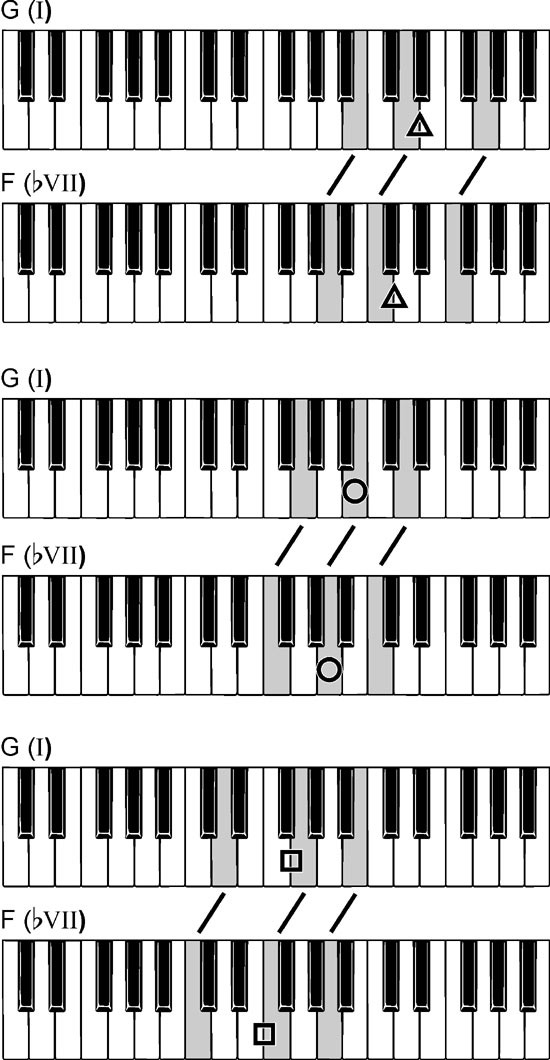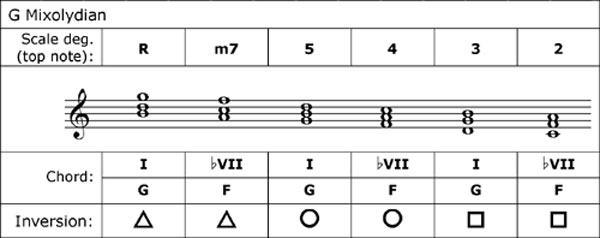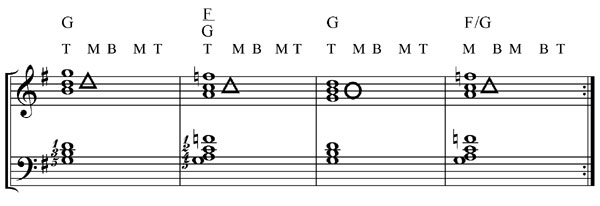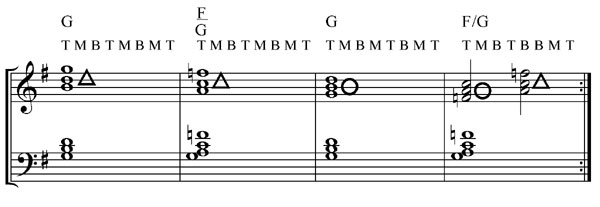The Musicarta Modes Workbook
The Mixolydian Mode (1)
The significant difference between the modern major key and the Mixolydian mode is that the Mixolydian mode has a minor (and therefore weak) dominant (v) chord but a strong (and useful) ëVII chord. This gives a fruitful pair of chords – I and ëVII, two major chords a whole tone apart, the upper one the tonic (home) chord. This module examines the pair’s potential.
Download up-to-date MIDI files for this page.
Here are the four riffs we build up to in this module.
Riff One
Riff Two
Riff Three
Riff Four
I and ëVII in G Mixolydian
As the white piano keys give us G Mixolydian without any alteration, we’ll examine the I–ëVII pair in G Mixolydian.
Any three-note chord (triad) can appear in three versions – root position, first inversion and second inversion. This means there are three next-door pairs of I and ëVII chords.

Here are the six chords in an analysis table.

The circle, square and triangle symbols indicate the inversion used.

If you do not read music, you can still find the chords using the keyboard diagrams or the Musicarta Visual Glossary – click through and print one for reference.
Play the descending chords at your keyboard. Note that the first inversion pair repeats at the end.

The two chords in each pair (in each bar) are exactly the same shape – all you have to do is move your hand one key to the left. It’s better, though, once you have found tye chords, to use the fingering given.
Notice that we now have a key signature – G major – and that we have to cancel out the black key F sharp to get the Mixolydian mode. Why bother with the key signature then? To let the musician know that we’re ‘in G’, even if it is a mode.
Riff One
If you add a left hand/bass part simply playing the roots of the chords (notes G and F) and a bit of a swing beat, you can already get a riff like this.
Before you try copying the audio, break it down. Listen to what the left hand and what the right hand does. Tap out the rhythm away from the keyboard:.

The beat is counted in quavers, above the beat map. If nothing happens on a particular quaver beat, the number is in brackets.
The letters T, L, R below the beat map stand for together, left, right, and indicate which hand or hands play. Feel free to forget the rhythm temporarily and tap the pattern as slowly as you need, to be sure that the TLR ‘events’ come in the right order.
Riff Two: I and ëVII over a pedal bass
This I–ëVII string of chords is often heard over a pedal bass. A pedal bass is a single bass note played under any number of different chords, and which doesn’t change when the chords change. In this case, it is G. ‘Pedal’ comes from the organ, where the bass notes are played with the feet pushing down big key-shaped pedals.
Do the rhythm analysis again.

No count is given – something happens on every quaver beat except beat 5.
The left hand plays off the beat all the way through. Slow it right down and use the TLR analysis to make sure you get the TLR ‘events’ in the right order.
The top row of letters is the ‘bottom, middle, top’ (BMT) analysis. You fill up quaver slots by playing the bottom, middle and top notes of the chord separately. (C stands for Chord – play the full chord, or just the top note.) Listen to the live audio riff as you read the beat map until you can hear how the two things refer to each other, then try to play.
Riff Three: I and ëVII chords in the left hand – with tonic pedal
Here is another tonic pedal construction, with the chords in the left hand.

Use the circle and triangle symbols to get the chord shapes from the keyboards diagram above if you need to.
Look at the chord symbols – you see ‘slash bass’ symbols. The slash bass symbols here say “This is an F chord with a different note – G – at the bottom.” Slash bass chord symbols can be written with the added bass note either under or after the chord symbol – both ways are shown here.
Because you have the chords in the left hand, you can play a ‘thinner’ right hand – you don’t need to play chords in both hands.
Ear training exercise
Listen to this audio clip.
You hear the familiar G and G major broken chords in the right hand, played in a repeated rhythmic pattern.
- Work out the right hand broken chord rhythm and practice it thoroughly.
- Find the chords at the keyboard. You know they will be G, F, G and F chords.
- Listen to the broken chord pattern in terms of bottom, middle, top notes and break up your chords accordingly.
Answers
The beat map (rhythm) is as follows.

Here are the chords with the BMT (bottom, middle, top) analysis shown.

Listen and check the BMT analysis against the audio again.
There is no written-out music for this riff – you have to get it from the audio clip and the illustrations.
Riff Four (variation)
Here’s another similar riff. The right hand notes come more quickly and are broken up into groups of three, three and two – a common trick in popular music.

Try to get the performance without the written music if you can.
Here is the MS if required.

The above riffs are mainly for inspiration and practice. You listen to them with a 'thinking ear’ – to hear how they’re made. Even if you can’t play them at first, you will probably discover some playable G Mixolydian riff that’s ‘a bit like’ the example along the way.
Keep your own version, and try again. You can expect learning these riffs to take a number of methodical attempts. Enjoy the journey!
|
OUT NOW! |
THE MUSICARTA BEAT & RHYTHM WORKBOOK At last! An effective approach to keyboard rhythm & syncopation skills. Learn more! |
ONLY $24.95! |
MODES |
The MusicartaA methodical approach to keyboard syncopation for
|
PUBLICATIONS
exciting keyboard
creativity courses
CHORDS 101
WORKBOOK

~HANON~
video course

Musicarta
Patreon
PENTATONICS
WORKBOOK
video course

Creative Keyboard
video course

BEAT AND RHYTHM
WORKBOOK

- Volume 1 -

12-BAR PIANO
STYLES WORKBOOK

MUSICARTA MODES
WORKBOOK

PIANO STYLE

CANON PROJECT
video course

VARIATIONS
video course


- Piano Solo -
video course

- Piano Solo -


YouTube playlists





 THE LOGO
THE LOGO
